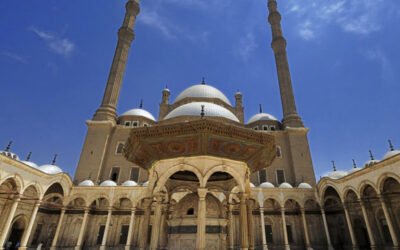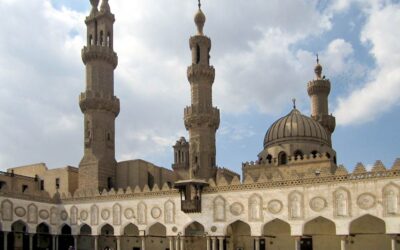Mausoleum of Imam al-Shafi’i
Mausoleum of Imam al-Shafi’i
- The Mausoleum of Imam al-Shafi’i honors Imam Al-Shafi’i, one of the four founding Imams of the Shafi’i school of Sunni jurisprudence. Situated on Imam Shafi’i Street in Cairo’s City of the Dead, this mausoleum stands as a prime example of Ayyubid architecture and holds significant historical importance.
- Imam al-Shafi’i journeyed to Cairo in 813, where he taught at the Mosque of Amr ibn al-As until his passing in 819. He was interred by his child, Ibn Abdulhakim, in the City of the Dead. In 1176, the Ayyubid sultan Salah ad-Din constructed a turbah and madrasa for Shafi’i, marking the first significant structure on his grave. Two years later, in 1178, a wooden coffin adorned with Islamic geometric patterns and Qur’anic inscriptions, as well as details of Shafi’i’s life in Kufic and Ayyub scripts, was crafted by Abid al-Najar.
- In 1211, following the death of his mother, Ayyub Sultan Al-Kamil built a mausoleum for her near Shafi’i’s grave. He also constructed a dome and an encompassing building over the entire area. This wooden dome, later enhanced with muqarnas and marble decorations by Mamluk Sultan Qaitbay in 1480, remains a notable feature. The structure underwent further restoration during the reign of Mamluk Sultan al-Ghuri and Ottoman wali Ali Bey al-Kabir in 1772, who added colorful decorations to the inner walls, muqarnas, and dome.
- Nearly four centuries after Imam al-Shafi’i’s death, Sultan Salah al-Din (Saladin) established a Sunni madrasa near his tomb and commissioned an elaborate wooden cenotaph carved from teak in 1178. This effort was part of the Ayyubid campaign to reinforce Sunnism following the fall of the Shi’i Fatimid Caliphate and to erase Shi’ism’s remnants in Egypt. Additionally, the construction of the madrasa near the grave of a prominent Sunni jurist highlighted the ongoing intra-Sunni conflict between Shafi’i Asharites and the Hanbalis.
- In 1211, Sultan al-Malik al-Kamil, mourning his mother, built a mausoleum near the graves of both al-Shafi’i and his mother. He topped the mausoleum with a large qubba or dome, one of the largest wooden domes of its time, surpassed only by the Dome of the Rock in Jerusalem. This mausoleum is considered the largest freestanding tomb in Egypt, and some scholars believe it was intended to bolster Sultan al-Kamil’s dynastic prestige as a burial place for himself and his family.
- The present structure largely dates back to al-Kamil’s era, though the wooden dome and several decorative elements such as the muqarnas were crafted by Sultan Qaytbay. Further alterations, including renovations to the dome’s outer layer and the addition of a fourth mihrab, were made by Sultan Qaytbay. Additional renovations took place between 1501-16 by Sultan Qansuh al-Ghuri and in 1772 by governor Ali Bek al-Kabir, who also embellished the dome and ornamental carvings.
- The most recent conservation effort began in 2016, addressing centuries of natural wear and exposure. Funded by the US Ambassadors’ Fund for Cultural Preservation, this initiative focused on restoring the dome, installing new lighting, and updating the drainage system. Significant repairs were made to the building’s exterior and interior stucco and masonry, addressing cracks and damaged fixtures.




